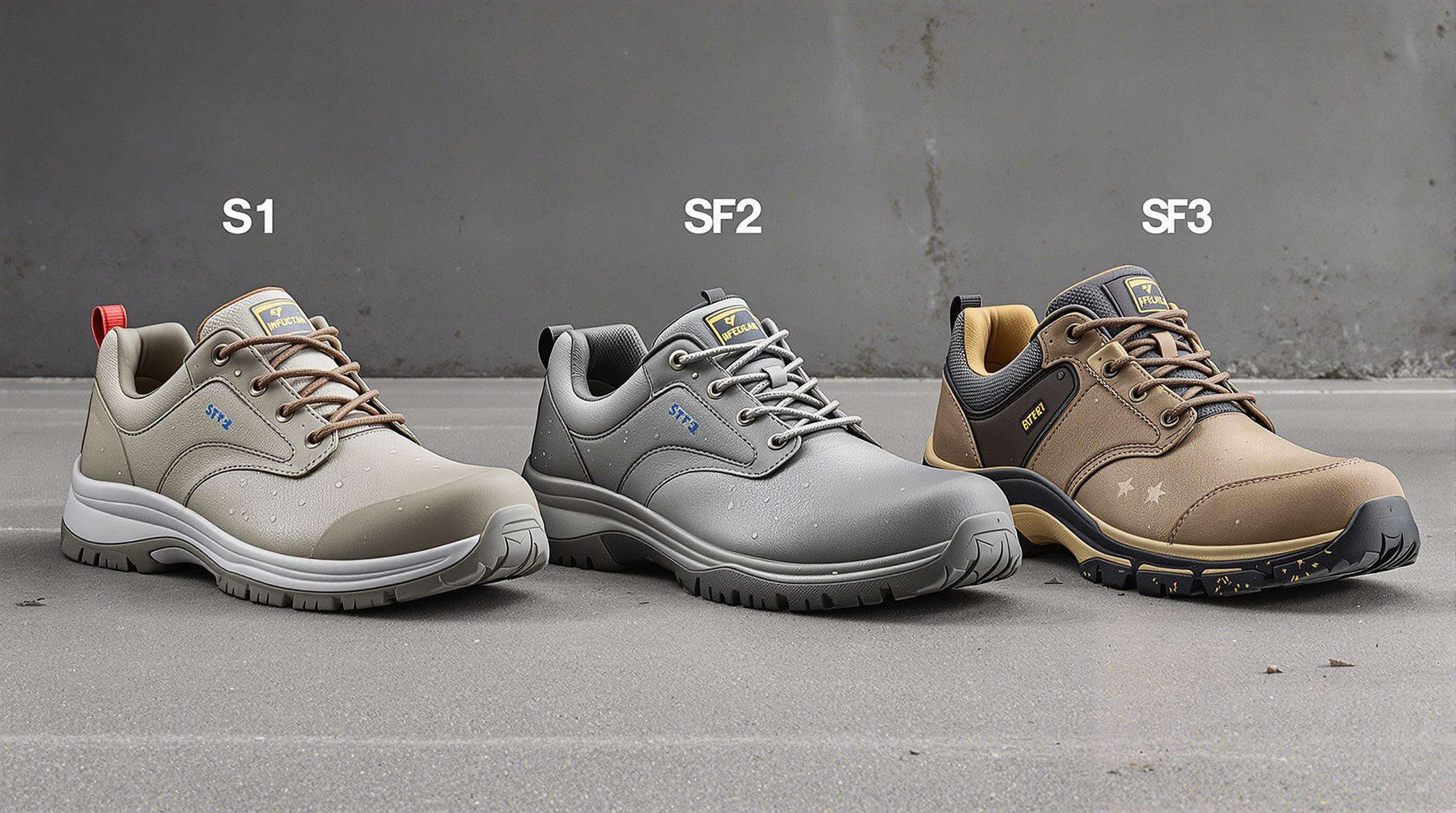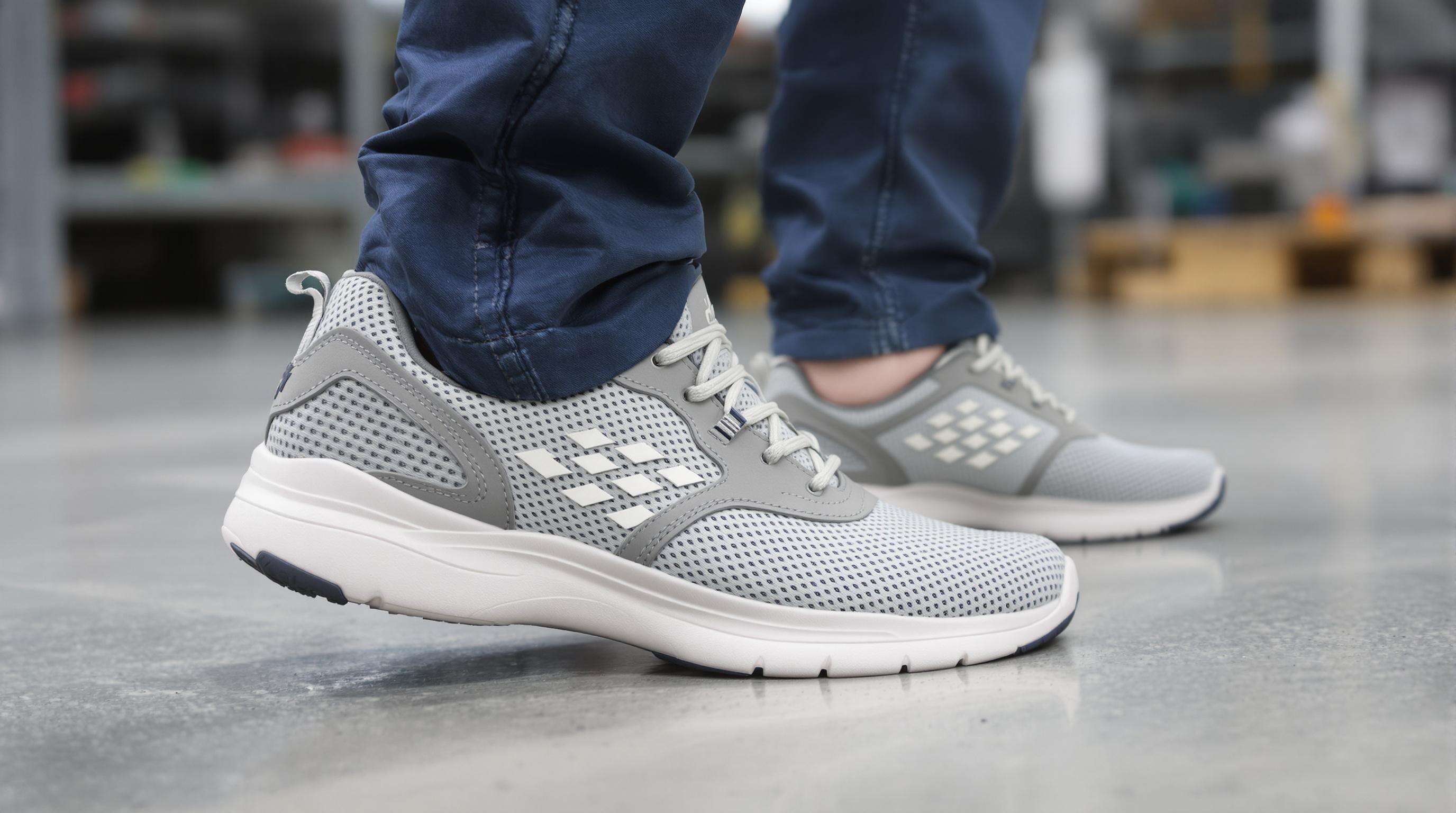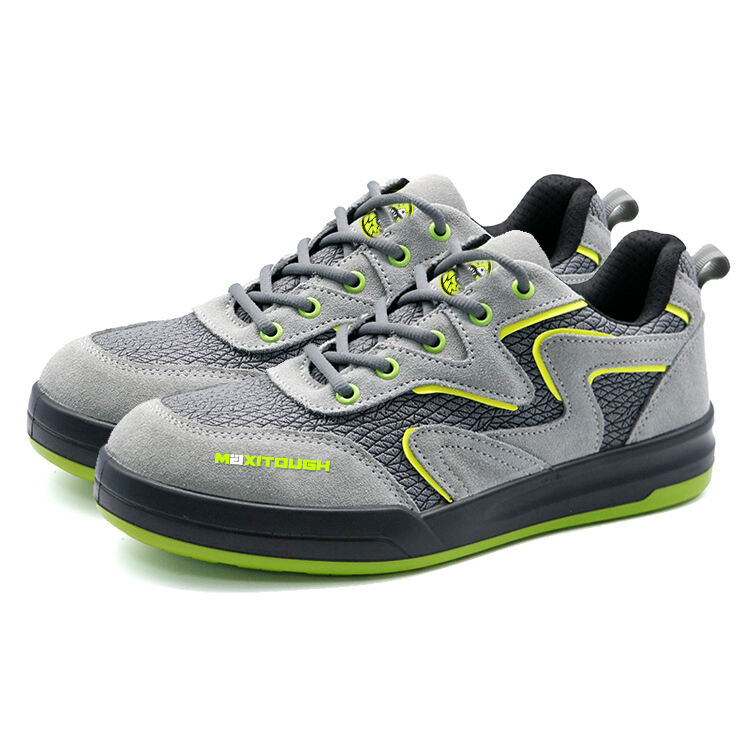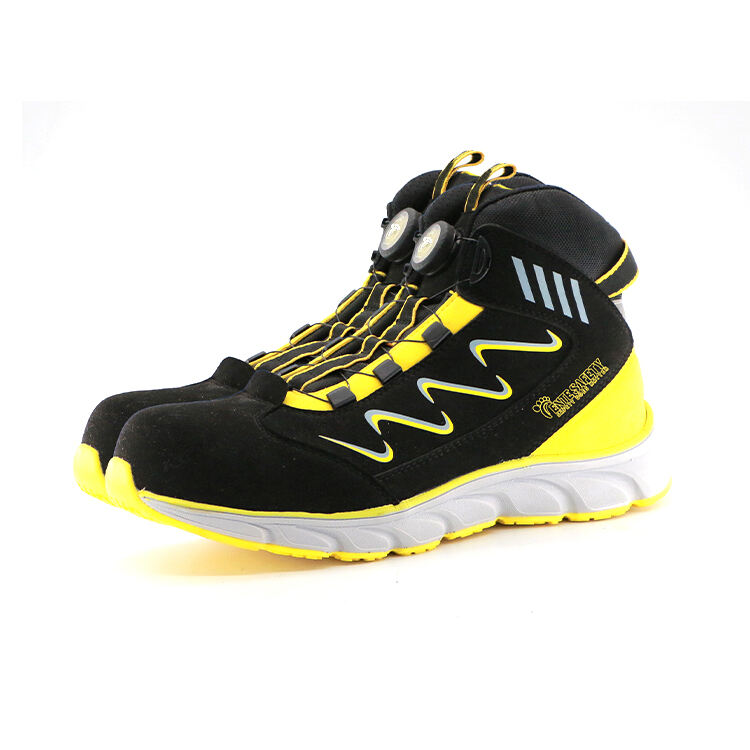
How to Choose the Right Safety Shoe Sneaker for Industrial
Understanding Safety Shoe Classifications (S1, S2, S3) and Industrial Applications

What Are S1, S2, and S3 Safety Shoe Classifications?
The letters S1, S2, and S3 are part of the European standard EN ISO 20345 when talking about safety footwear specifications. Let's start with S1 which offers basic protection requirements such as an anti-static sole, a heel that can absorb energy, and a toe cap that stands up to impacts of around 200 joules. Moving on to S2 brings additional benefits like water resistant materials in the upper part of the shoe, making them better suited for places where workers might get their feet wet, think about food processing plants for instance. Then there's S3 which basically combines everything from S1 and S2 but goes one step further by adding soles that resist punctures from sharp objects like nails or other debris lying around worksites. These different levels allow manufacturers to create safer yet more comfortable options for workers who need protection but also want some degree of mobility. We're seeing more interest lately in what some call "safety shoes sport" as companies try to balance worker safety with comfort in increasingly dynamic work environments.
Key Differences Between S1, S2, and S3 Safety Shoes
Getting the right classification makes all the difference when matching shoes to hazards on site. The S1 category works well for basic dry environments such as storage facilities where there's little risk of slipping or falling objects. Moving up to S2 means we get complete waterproofing features that protect against moisture during outdoor work or around kitchen areas prone to spills. Then there's S3 which really steps things up a notch with reinforced steel soles capable of withstanding pressures up to 200 Newtons per square millimeter. These kinds of specs matter a lot in tough industries like building construction or factory floor operations where foot injuries are common concerns. By following this stepped system, companies avoid buying unnecessarily expensive gear but still meet safety standards across different job sites.
| Feature | S1 | S2 | S3 |
|---|---|---|---|
| Water Resistance | Partial | Full Upper | Full Upper |
| Penetration Protection | None | None | Steel Midsole |
| Typical Applications | Indoor Warehousing | Food Processing | Construction Sites |
Matching S1, S2, S3 Ratings to Specific Work Environments
When workers match their shoes to job site dangers, injuries drop dramatically according to National Safety Council numbers from last year showing about a 60% reduction. For folks putting together electronic components, S1 rated boots are pretty much standard gear since static electricity can wreck havoc on sensitive parts. Landscapers and beer makers tend to go for S2 protection because they deal with all sorts of slick surfaces that just wait to trip someone up. Construction crews working near钢筋 bars or out in the woods need S3 level protection as per OSHA requirements most of the time. Hospitals have started using modified S1 versions too, especially when doctors and nurses need foot protection from rolling carts and medical equipment while still maintaining those strict cleaning protocols between patients.
S1P and S3 ESD Standards in Lightweight Safety Sneakers
The S1P classification takes regular S1 shoes and adds those tough stainless steel insoles that can handle up to 1100 newtons of force. That kind of protection is really important for workers on rooftops or in recycling facilities where foot injuries are common. Then there's the S3-ESD version which keeps static electricity under control at less than 100 kiloohms resistance. These special shoes have become must-haves for people working in places like aerospace factories and cleanrooms where even tiny sparks could cause major problems. What makes these safety boots stand out is how they combine all this protection with designs that look more like sport shoes than traditional work gear. Workers actually wear them comfortably throughout their long 12 hour days on the job site. Interestingly enough, around 36 percent of all orders coming into industrial supply companies these days are for lightweight composite materials instead of metal parts in footwear construction.
Essential Safety Features in Industrial Safety Shoe Sneakers
Safety Toe Options: Steel, Composite, and Aluminum Compared
When it comes to protecting feet from impacts, there are basically three main types of toe cap materials workers can choose from. Steel toe caps are tough enough to handle around 200 joules of force, which is pretty impressive for foot protection. However, steel does have downsides too. It conducts heat and cold right through to the skin, plus those boots tend to feel heavier at the end of a long day. Composite materials like Kevlar, plastic, or fiberglass solve some of these problems by cutting out the conductivity issue entirely. They also make boots about 30% lighter overall, although this benefit comes at a cost since composite toes need to be built thicker to maintain their protective qualities. Aluminum offers something different altogether. Not as heavy as steel but still decently protective, aluminum toes resist rust much better than other options when working in damp conditions or near water sources. The choice really depends on what matters most in a particular job setting. If absolute protection is critical, steel remains king. For jobs where electricity might be a concern, composites become safer bet. And anyone dealing regularly with moisture will probably appreciate aluminum's resistance to corrosion over time.
Slip-Resistant and Puncture-Resistant Soles: Technology and Performance
Good quality soles are made from special mixtures of materials and have specific patterns on the bottom to help workers avoid accidents at work. Rubber soles that resist oil have tiny grooves which cut down slips by around half when walking on oily floors according to research from National Safety Council last year. These soles also include layers that stop sharp objects like nails from going through them. The newer models often feature EVA foam inside that absorbs shocks better but still keeps the protective qualities intact something really important for those safety shoes that look more like sports footwear these days combining real protection with comfortable fit. Before buying any footwear though, it's worth checking whether they actually satisfy the grip requirements needed for whatever floor surfaces people will be standing or walking on during their jobs.
Upper Materials and Their Impact on Durability and Protection
- Full-grain leather provides optimal abrasion resistance in high-wear industrial zones but limits breathability
- Synthetic meshes enable airflow during extended shifts but require nano-coating treatments for chemical resistance
- Waterproof membranes block liquid ingress while allowing vapor transmission for climate control
Material selection directly influences footwear lifespan. Rugged environments demand reinforced zones near toe caps and flex points. Prioritize seamless constructions where possible to eliminate moisture-trapping stitching weak points.
Comfort Meets Safety: Designing for Long-Wear Performance in Safety Sneakers

The rise of Safety Shoes Sport trends has redefined industrial footwear, blending athletic-inspired comfort with rigorous safety standards. Prioritizing wearability without compromising protection ensures workers stay productive and injury-free during demanding shifts.
Why Comfort and Breathability Matter in Industrial Footwear
When safety boots are uncomfortable, workers are about 34% more likely to skip wearing them altogether according to Ponemon's 2023 study, which naturally raises the risk of injuries on the job site. Good quality boots now come with breathable mesh tops that let air circulate and linings that pull sweat away from the skin, cutting down on those annoying fungal problems and painful blisters. The cushioning in the middle part of these shoes really helps take the strain off feet when someone has been standing all day long. And here's something interesting: shoes designed with proper ventilation can cut foot fatigue by roughly 22% even in hot, sweaty conditions. This kind of comfort makes it much easier for workers to stick with their safety gear requirements over time instead of giving in to temptation and going barefoot or wearing regular shoes.
Lightweight Safety Sneakers for Indoor and Extended Shifts
Today's safety boots are getting lighter thanks to materials such as carbon fiber and TPU, making them about a third lighter than older models while still protecting toes properly. Take a look at what the latest industrial footwear studies show these days - many manufacturers now include PU injected soles which really help workers who spend all day on their feet in warehouses. The improved design lets people move around better in tight work areas, something that matters a lot in factories where space is limited. And this fits right into what OSHA has been emphasizing lately about creating workplaces that are easier on the body overall.
Ergonomic Design and Its Impact on Worker Productivity
Shoes that have proper arch support and shaped heels can really help workers maintain better posture at work. According to data from the Bureau of Labor Statistics back in 2023, people working on factory floors reported about 19% fewer issues with lower back pain after switching to this kind of footwear. Research also indicates that shoes with sloped toe areas and bendy soles make all the difference when someone needs to climb ladders or walk across rough ground. These design elements cut down on slips and falls, which means less time lost due to accidents. When companies invest in footwear that works with how feet naturally function rather than against them, productivity tends to go up. Some workplaces actually saw their employees finish tasks 15% faster once they started wearing these supportive shoes. Makes sense really - comfortable feet lead to happier workers who get things done quicker.
Selected Safety Shoe Sneakers by Work Environment and Industry Needs
Choosing Footwear for Wet, Oily, or Rough Terrain Conditions
People working around wet floors, oil slicks, or rough terrain really need good safety shoes with those SR rated soles that resist slipping and have deep treads for grip. Take a look at S3 rated boots with TPU outsoles instead of regular rubber soles. According to some industry data from last year, these can cut down slip accidents by about forty percent which makes all the difference when walking across greasy factory floors. Workers in chemical processing facilities should also think about combining puncture proof midsoles with something like Sympatex membranes inside their boots. This setup stops liquids from getting in but still lets feet breathe properly, which matters a lot during long shifts where comfort becomes just as important as protection.
| Work Hazard | Critical Safety Features | Ideal S-Rating |
|---|---|---|
| Wet/oily floors | Slip-resistant (SR), oil-resistant outsoles | S2/S3 |
| Rocky terrain | Thick midsoles (≥4 mm), ankle support | S3 |
| Metal debris | Metal-free composite toe caps, Kevlar® lining | S1P |
Best Practices for Using Safety Sneakers in Industrial Settings
Footwear should be replaced roughly once a year or when it hits around 1,000 hours of wear time because studies show worn out soles can lose about two thirds of their grip on slippery surfaces according to research from Occupational Health Journal last year. For folks working on construction sites, combining S3 rated shoes with proper metatarsal protection makes sense while those in electronics manufacturing need to look for models with ESD features built in. Checking shoes daily for signs like separating soles or exposed toe caps actually stops most foot injuries before they happen since gear that's starting to break down accounts for nearly three quarters of all workplace foot problems.
Bridging the Gap: High Safety Standards vs. Worker Comfort Preferences
According to a recent 2023 study, nearly two thirds of workers actually bypass their safety footwear because they find it uncomfortable, which puts them at triple the risk of getting hurt on the job. The latest generation of safety boots is starting to address these issues though. Some models feature special aerogel inserts that keep feet cool even in hot foundry environments, while others have stretchy knit tops that work well with custom orthotics but still maintain proper S3 protection against impacts. Companies are finally figuring out how to combine the necessary safety standards from EN ISO 20345:2022 with the kind of comfort we see in regular athletic shoes. This combination has made a real difference in factories where people stand all day long. Workers report feeling less tired after wearing these new designs for full 12 hour shifts, with some studies showing around a third reduction in overall fatigue levels according to the Ergonomics Institute findings last year.
The Rise of Safety Shoes Sport: Trends Shaping Modern Industrial Footwear
Merging Athletic Design with Industrial Safety: The Safety Shoes Sport Trend
The world of industrial shoes is changing fast these days, mixing looks from athletic sneakers while still meeting those important ANSI/ISEA safety requirements. Big name brands are starting to put more thought into comfort features we see in running shoes lately breathable mesh tops, cushiony midsoles that respond well, and heels that adjust to different foot shapes all without making the shoes any less protective against impacts. According to some research done last year by Safety Equipment Institute folks, around two thirds of younger workers (those under forty) actually prefer these sporty looking safety boots instead of the old fashioned heavy duty styles they used to wear. They mention being able to move better and work faster on factory floors and in warehouses when wearing them.
Meeting Millennial and Gen Z Expectations with Work Sneakers
Younger workers demand footwear that transitions seamlessly from production floors to break rooms. Key drivers include:
- Color customization: 62% of buyers aged 18–34 select shoes with reflective accents or brand-color matching (Industrial Safety Gear Report 2024)
- All-day comfort: Technologies like memory foam collars and torsion control shanks reduce foot fatigue during long shifts
- Brand collaborations: Major safety brands now partner with sportswear companies to co-develop safety sneakers with recognizable silhouettes
Future Innovations: Smart Soles, Sustainable Materials, and Custom Fit
What's coming next? Embedded IoT sensors in footwear that map pressure points on the sole and send alerts when someone starts slipping before they actually fall. Some recent testing suggests these smart soles might cut down on workplace accidents by about 31 percent, particularly useful in dangerous industries such as oil and gas operations. At the same time, most procurement managers are starting to demand safety shoes made from at least 40% recycled stuff these days. This trend has pushed companies toward using things like algae based foams for cushioning and rubber soles made from old tires. A look at the 2023 Sustainable PPE Survey backs this up, showing that over two thirds of those responsible for buying equipment want greener options now.
FAQ
What are the main features of S1, S2, and S3 safety shoes?
S1 shoes offer basic protection with anti-static soles and impact-resistant toe caps. S2 shoes add water resistance to the upper part, while S3 shoes include puncture-resistant soles with a steel midsole.
Where are S1, S2, and S3 safety shoes typically used?
S1 shoes are suitable for indoor warehousing, S2 shoes for food processing areas, and S3 shoes for construction sites.
What does S1P mean in safety shoe classifications?
S1P refers to safety shoes that combine S1 features with penetration-resistant midsoles capable of handling heavy forces.
How often should safety sneakers be replaced?
Safety sneakers should be replaced approximately once a year or after 1,000 hours of wear to ensure maximum safety and performance.

 EN
EN
 AR
AR BG
BG HR
HR CS
CS DA
DA NL
NL FI
FI FR
FR DE
DE EL
EL HI
HI IT
IT JA
JA KO
KO NO
NO PL
PL RO
RO RU
RU ES
ES SV
SV TL
TL ID
ID SR
SR VI
VI HU
HU MT
MT TH
TH TR
TR AF
AF MS
MS GA
GA BN
BN NE
NE

